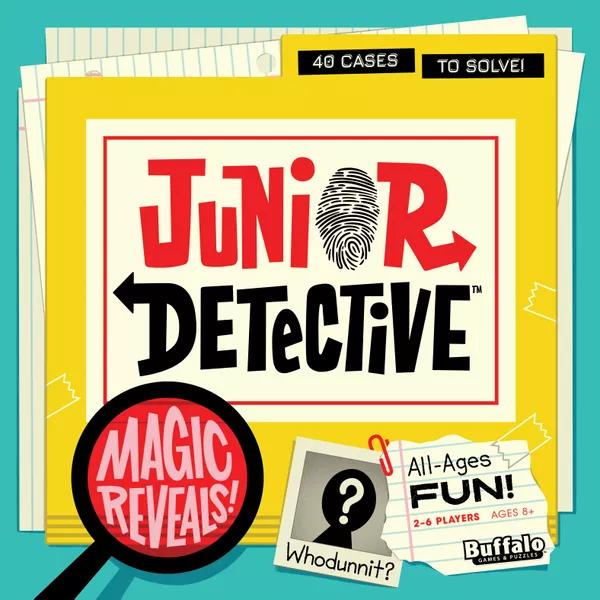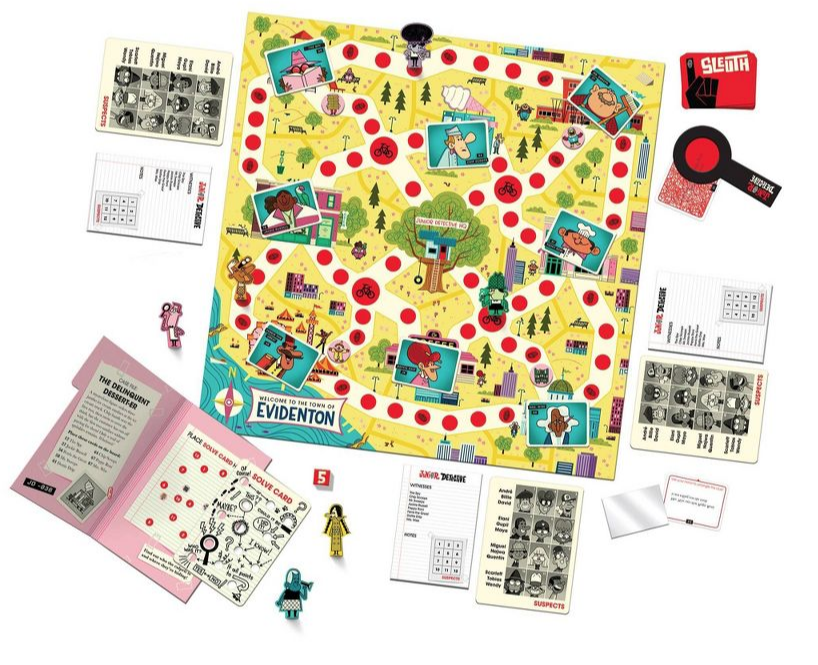Solve Forty Cases and Catch Conniving Culprits in Junior Detective

Put on your thinking cap, canvas the town for key witnesses, and deduce the culprit in this game of deduction and mystery.
Published by Buffalo Games, Junior Detective is a 20-minute mystery deduction game for 2-6 players (intended for kids and families).
Gameplay
The board is set in the center of the table. It shows nine locations connected by various paths. Players each select a detective meeple to play and place it at the central location. Players also select one of the 40 cases to play. Each case has a one-paragraph story to set the scene and then tells you which witness card to place face-down at each location. There will always be the same eight witnesses in the game, but the card used for each one will determine what they saw.
Each player takes a suspect board. This shows twelve different people. One of them is the culprit in the present case. Additionally, there are four hiding tokens placed at specific locations on the board.
On your turn, you roll the die and move your pawn that many spaces, choosing the path you wish to follow. You may not pass a hiding token. If you land on a location, you may choose to stop and question the witness there; if you land on a sleuth space, you draw a sleuth card; and if you land on a bicycle space, you may immediately move to anywhere on the board.
When you question a witness, if it is one of the six main regular witnesses, then you use the red spyglass included with the game to read the text on the card. Witnesses will give you pieces of information to help you narrow down who is the guilty party, such as the culprit ‘was wearing a hat’ or ‘does not have glasses’. Each player has a paper on which to track the information they gather.
If you question Mrs. Wise, she will always tell you who, if any, of the witnesses is lying. To read her card you must use a mirror. Finally, the spy will tell you which of the four hiding tokens the culprit is currently hiding at. To reveal her information you are supposed to use the warmth of your hands and rub the card between your palms.
When you draw a sleuth card, you must read it aloud and do what it says. This might allow you to move a hiding token to block a player off from a specific path, move you to a new location, or it might even force you to share some of the information you’ve already gathered.
The first player to go to the correct hiding token, and announce the culprit correctly, consulting the case booklet to check his answer, wins the game.

Review
Junior Detective is an enjoyable deduction game for kids and families. The stories in the cases are all about minor annoyances and pranks, and the deduction elements are more about finding the information than trying to piece clues together. What it does, it does well.
It is not a game with a lot to offer an adult game group, and not one you’d pull out without kids. That being said, there is a lot for children to enjoy here — it’s a nicely put-together deduction game, with great, colorful artwork and atmosphere, and you can have a good time playing it as an adult, with a younger audience. We did legitimately enjoy our time with this game, and played several extra cases simply for the fun.
We did come across one typo in the second case, where it called for you to use the wrong witness card. We also wondered if you might start to remember some of the witness card numbers and what pieces of information they related to. However, a younger audience would probably be less likely to have this issue, and we do appreciate the fact that after playing through all forty cases you could absolutely play through them again, without danger of remembering the solutions.
There was, however, another component issue we encountered: all the information on the spy cards was already visible and no heat from our hands was necessary to reveal it. I don’t know if this came from playing the game during the summer in Arizona, or if the cards were just defective. Either way it was a shame, as that was the coolest clue reveal mechanism in the game, and we were disappointed not to be able to play with it.
Despite these component issues, Junior Detective is fast to teach, keeps the playing field pretty even so families can enjoy it together, and has a satisfying 20-minute playtime. Having different ways to read the clues adds a fun, tactile experience to the game. There’s just a little take-that with some of the sleuth cards as you move hidden tokens to block players or move them to other locations — even if you’re on the back foot, if you see someone else about to make an accusation you can attempt to race to a hiding token to make it your own. And when the case is solved, it is quite satisfying.
Pros: Different mechanics for reading the clues, number of cases and replay value, art style
Cons: A couple of component issues, unlikely to appeal to adult game groups
Disclosure: we received a complimentary review copy of this game.






